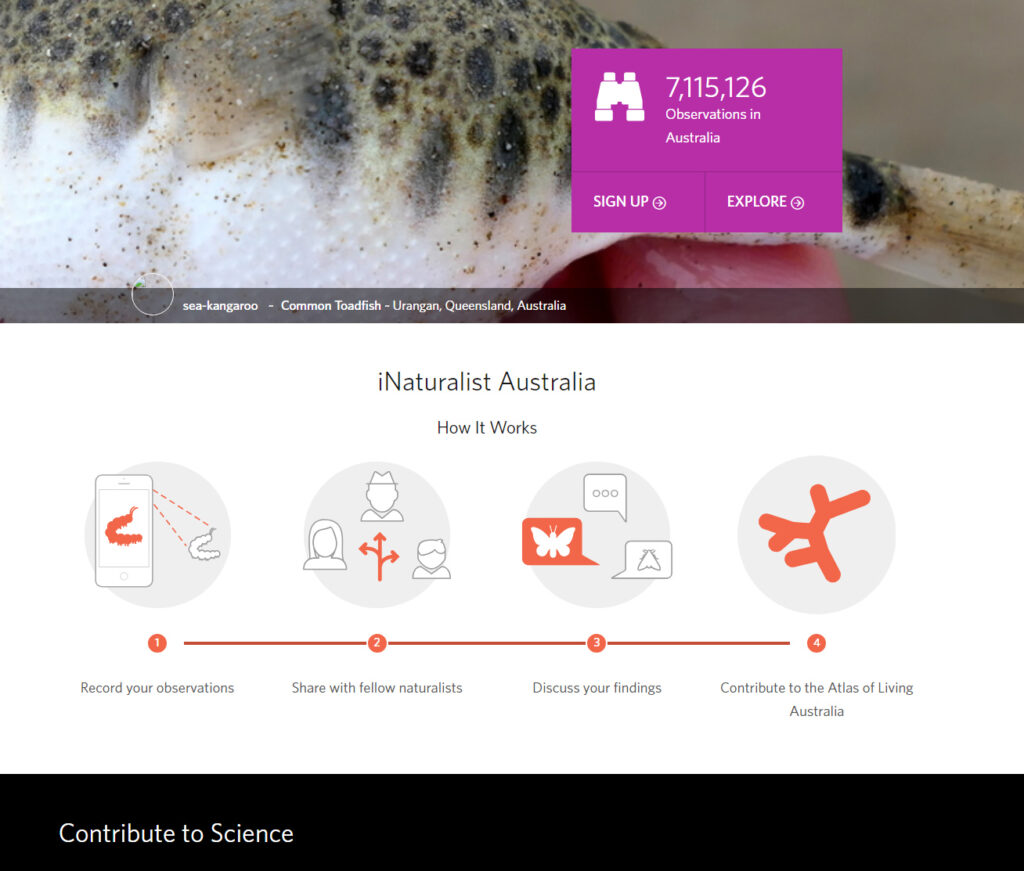The inaugural Great Southern Bioblitz (GSB) was in 2020. The Castlemaine Field Naturalists Club joined in 2021 and has taken part every year since. Each Bioblitz is held over 4 days in spring (September to November) with an iNaturalist project established to collect the observations. Observations, photos and/or recordings within the Mt. Alexander Shire and the eastern half of Hepburn Shire are uploaded to iNaturalist where they are included in our project.
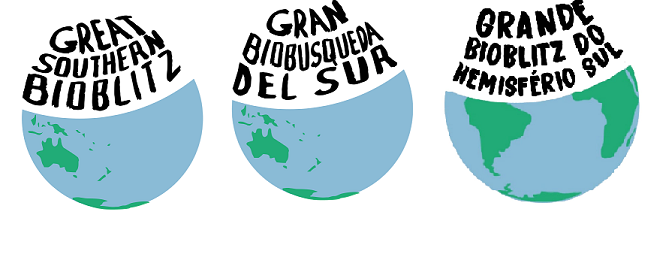
How to take part in the Great Southern Bioblitz
- Create an account on iNaturalist and/or load the iNaturalist app to your phone.
- Watch the Introduction to iNaturalist by The Beachcomber.
- During the 4 days of the GSB take photos or record the sounds of natural life in your area. Take the quick quiz “iNat-or-iNot” to learn what to record.
- During the GSB and for 2 weeks afterwards, load your observation onto iNaturalist, Make sure that you have the correct date and location for your observations.
- Identify observations other people have loaded to iNaturalist.
- Connect with other naturalists across the globe.
- Have fun and learn as you go.
The Journey So Far
This article is the first interrogation of the accumulated data. The analysis is not exhaustive but will perhaps offer suggestions for more detailed analysis and how to prepare for future Bioblitz. There are many factors which can influence the bias of the data including seasonal factors, mismatched timing of the bioblitz across years, and the many human factors such as rare or conspicuous species being over-represented.
Spring 2021: 22nd to 25th October
This was the first year that we took part in the GSB. See the summary (below) of what we found in 2021 and take a closer look at our project and the Umbrella site for the year which shows all groups.
| See notes below for an explanation of the categories. | Total | Plants | Birds | Insects | Amphibians | Animals | Arachnids | Fungi | Mammals | Molluscs | Reptiles |
| All observations Verifiable | 1828 | 1221 | 168 | 292 | 4 | 20 | 47 | 54 | 7 | 1 | 14 |
| All observations Research Grade | 1266 | 938 | 166 | 103 | 4 | 13 | 15 | 6 | 6 | 1 | 14 |
| All species Verifiable | 575 | 322 | 63 | 119 | 2 | 8 | 21 | 24 | 4 | 1 | 11 |
| All species Research Grade | 430 | 277 | 63 | 53 | 2 | 4 | 11 | 5 | 3 | 1 | 11 |
| Threatened | 16 | 15 | 1 |
Spring 2022: 28th to 31st October.
See the summary (below) of what we found in 2022 and take a closer look at our project and the Umbrella site for the year which shows all groups.
| See notes below for an explanation of the categories. | Total | Plants | Birds | Insects | Amphibians | Animals | Arachnids | Fungi | Mammals | Molluscs | Reptiles |
| All observations Verifiable | 2173 | 1384 | 195 | 274 | 16 | 28 | 26 | 207 | 30 | 5 | 8 |
| All observations Research Grade | 1439 | 1020 | 194 | 108 | 13 | 18 | 7 | 41 | 27 | 4 | 7 |
| All species Verifiable | 622 | 347 | 63 | 112 | 4 | 14 | |||||
| All species Research Grade | 452 | 273 | 63 | 66 | 4 | 3 | 6 | 16 | 8 | 2 | 7 |
| Threatened | 14 | 11 | 3 |
Spring 2023: 24th to 27th November
See the summary (below) of what we found in 2023 and take a closer look at our project and the Umbrella site for the year which shows all groups.
| See notes below for an explanation of the categories. | Total | Plants | Birds | Insects | Amphibians | Animals | Arachnids | Fungi | Mammals | Molluscs | Reptiles |
| All observations Verifiable | 2474 | 1130 | 375 | 735 | 18 | 30 | 65 | 65 | 34 | 4 | 18 |
| All Observations Research Grade | 1579 | 796 | 372 | 293 | 15 | 20 | 25 | 4 | 33 | 4 | 17 |
| All species Verifiable | 721 | 293 | 85 | 253 | 5 | 629 | 29 | 15 | 1 | 5 | 6 |
| All species Research Grade | 456 | 212 | 85 | 117 | 5 | 3 | 9 | 4 | 15 | 1 | 5 |
| Threatened | 16 | 12 | 3 | 1 |
Notes
‘Verifiable Observation’
This status is applied to any observation that is uploaded that contains a valid date, a location, has photo or sound, and isn’t of a captive/cultivated organism. Without any one of these vital pieces of information, an observation cannot reach Research Grade and is not shared with the Atlas of Living Australia (ALA). Reseach Grade observations are a sub-set of Verifiable observations.
‘Research Grade’
This status is achieved when a ‘Verifiable Observation’ has been reviewed and the community is in agreement on the ID. The observation will now be shared with the ALA and other iNaturalist partners.
In the graphs below, the category ‘All other categories’ is the sum of ‘Amphibians, Arachnids, Fungi, Mammals, Molluscs, Other Animals & Reptiles’. In these groups there were insufficient observations for meaningful comparisons.
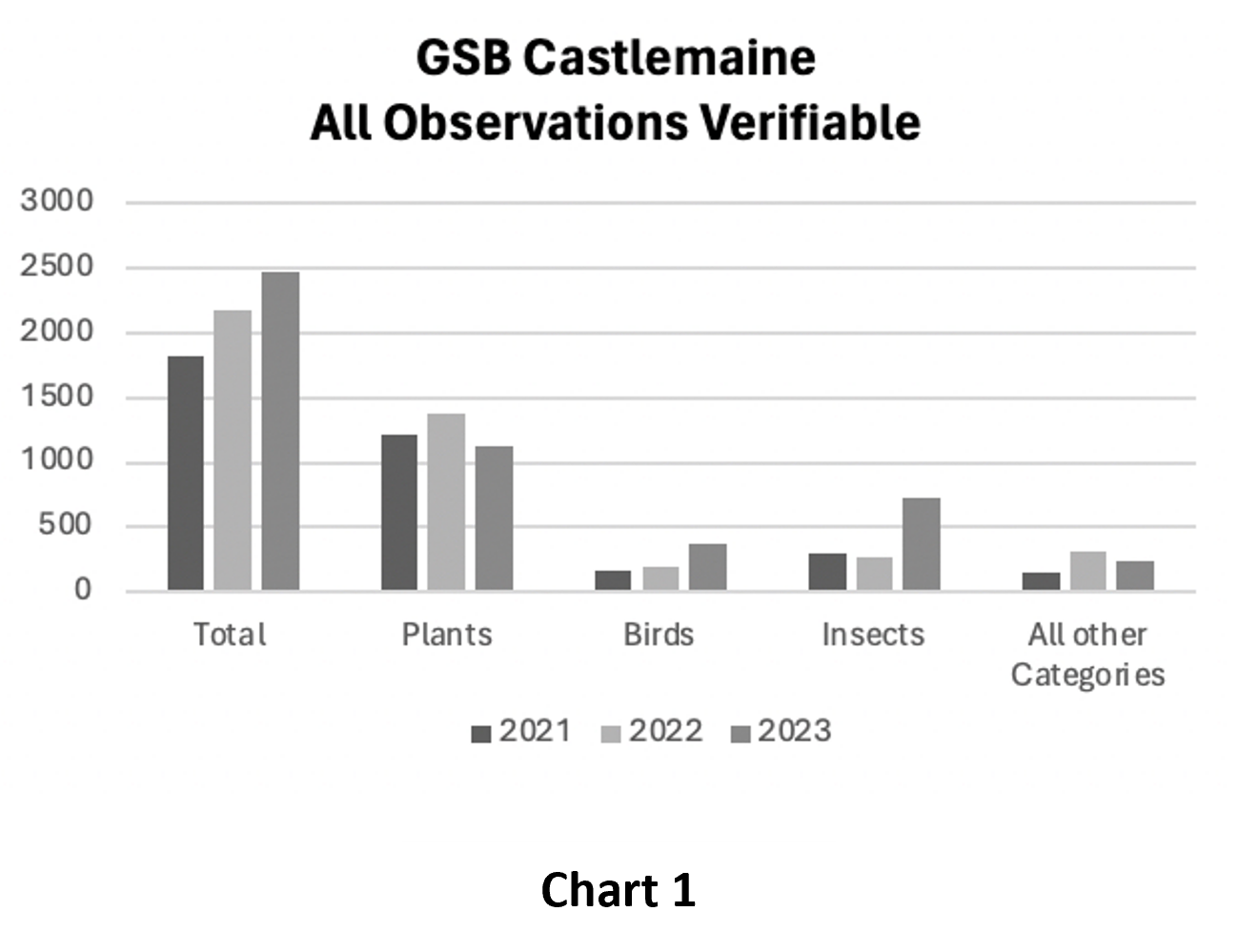
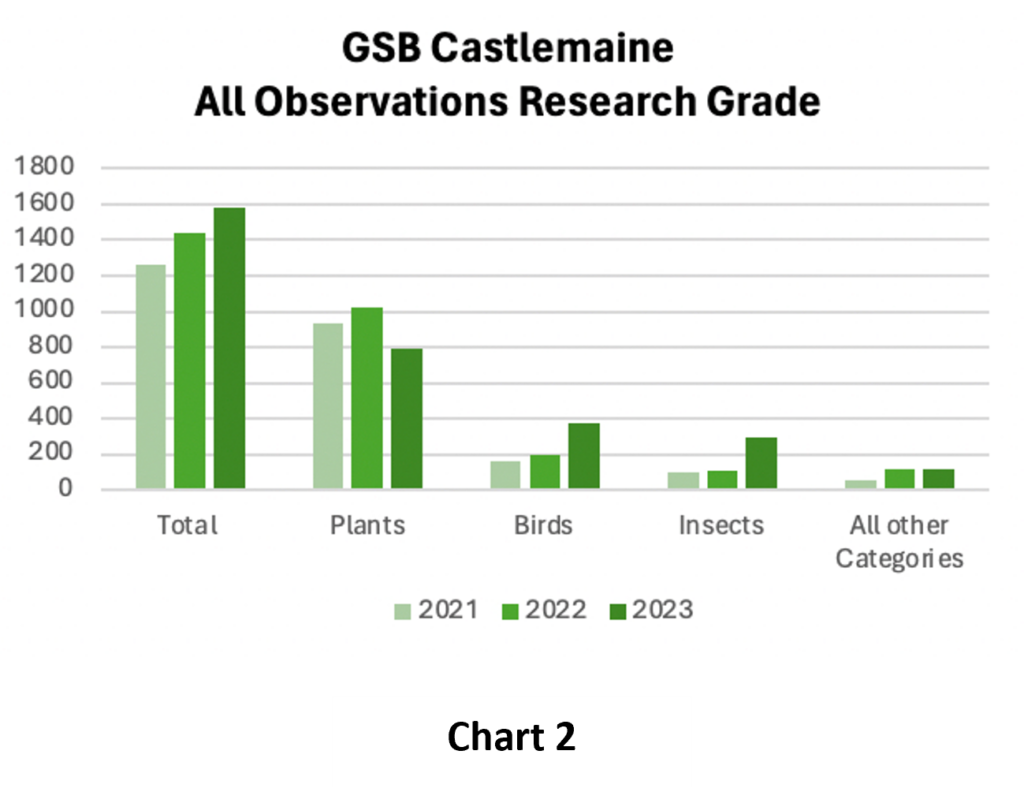
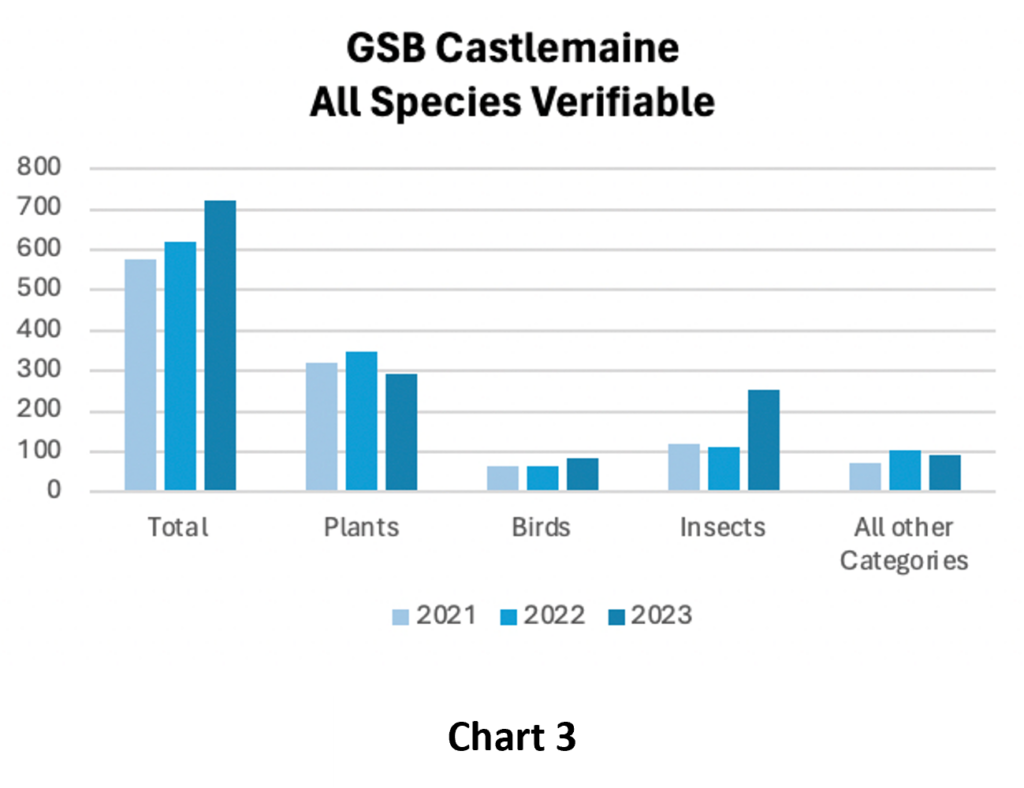
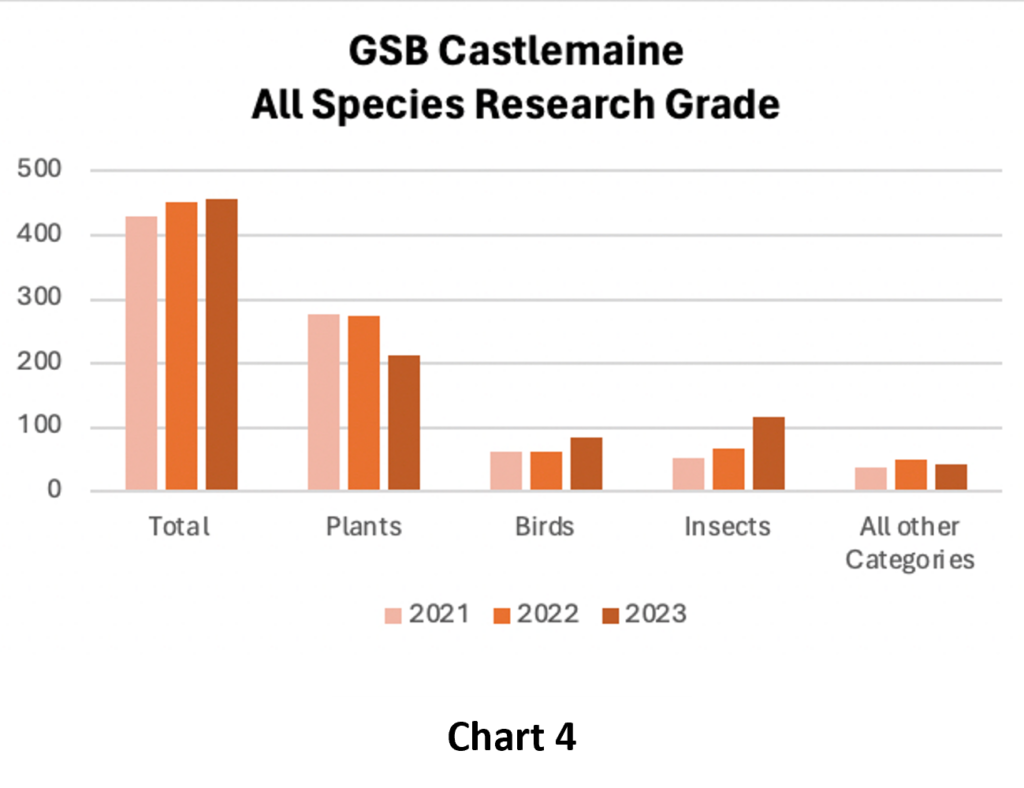
The first point to note is that the number of observations increased each year (Charts 1 & 2). This is expected as the number of participants increased from 28 in 2021 to 38 in 2022 but 37 in 2023. Although there is a core group of observers who have participated in all 3 Bioblitz, there are others who have participated in only one of the three Bioblitz. The increase in total observations from 2022 to 2023, 38 and 37 observers respectively, could be due to the increased experience of each of the observers in 2023.
Bioblitz 2022 shows a significant increase in plant observations. The timing was shortly after the heavy rainfall. The data were not examined to identify how many invasive weeds were included. However, in late November 2023, many native plants had already finished flowering and they may have been overlooked.
In 2023, the moth night, held on November 25th was the first time for this dedicated activity. Together with the later time of the year and the milder weather, these factors may account for the higher number of insect and bird observations in 2023.
Also noteworthy is the increase of Fungi observations in 2022. Again this may be attributable to the high rainfall in late winter and spring.
While the total number of observations is fixed for the time of each GSB project, species identification values may change as experts and knowledgeable people make further confirmations upgrading ‘verifiable’ to ‘research grade’ status (Charts 3 and 4). In some instances this could take a year or more. The quality of the photos which include clear identification features may also influence the level of species identification as will the number of people with sufficient knowledge to accurately identify some species.
Personal preferences, locations (grasslands, forests creeks or higher altitude), time of day/night, the season and weather (rain, sun, wind) will always influence which observations are made.
Threatened Species
The ‘Threatened’ classification is a grey area. It may be influenced by data sources such as:
(1) The International Union for Conservation of Nature’s Red List of Threatened Species (IUCN Red List); In the table below the IUCN threat status may only be relevant to some named sub-species.
(2) The Federal Government’s Environment Protection and Biodiversity Conservation Act 1999 (EPBC);
(3) The Victorian Government’s Flora and Fauna Guarantee Act 1988;
(4) Other regional and local data sources such as – Threatened Species Scientific Committee, Indigenous Advisory Committee and the CSIRO among others.
For example, The IUCN and iNaturalist list the European Rabbit Oryctolagus cuniculus as ‘Threatened’ within its natural range in areas of Europe and north Africa!! iNaturalist lists the Fryerstown Grevillea, Grevillea obtecta as ‘Threatened’ but the FFG lists it as ‘Endangered’ while it is not listed at all on the IUCN. FFG lists the Small-flower Grevillea Grevillea micrantha as Critically endangered.
During the GSB Castlemaine 2021 and 2023, the European Rabbit was observed and uploaded into the respective projects. They are valid observations and have been identified at research grade but the European Rabbit, has not been included in this survey as a ‘threatened’ mammal’ in the Mt. Alexander / Hepburn Shires. Red-flowering Gum, Corymbia ficifolia, and Pincushion Hakea, Hakea laurina, both native to WA and introduced to our region were likewise, not included in the analysis.
Nearly all threats to the global flora and fauna can be attributed to humans – the conflict between human activities and the conservation of our environment. Some of the major threats include global warming, habitat loss due to exploitation of natural resources or changed land use, the over-exploitation of wildlife and plants for commercial purposes including trade of rare or charismatic species, novel diseases and competition from the introduction of invasive non-native species. While many species may be threatened locally due to human or environmental factors this local status has not been picked up by this analysis.

Photo: b_sydes, iNaturalist
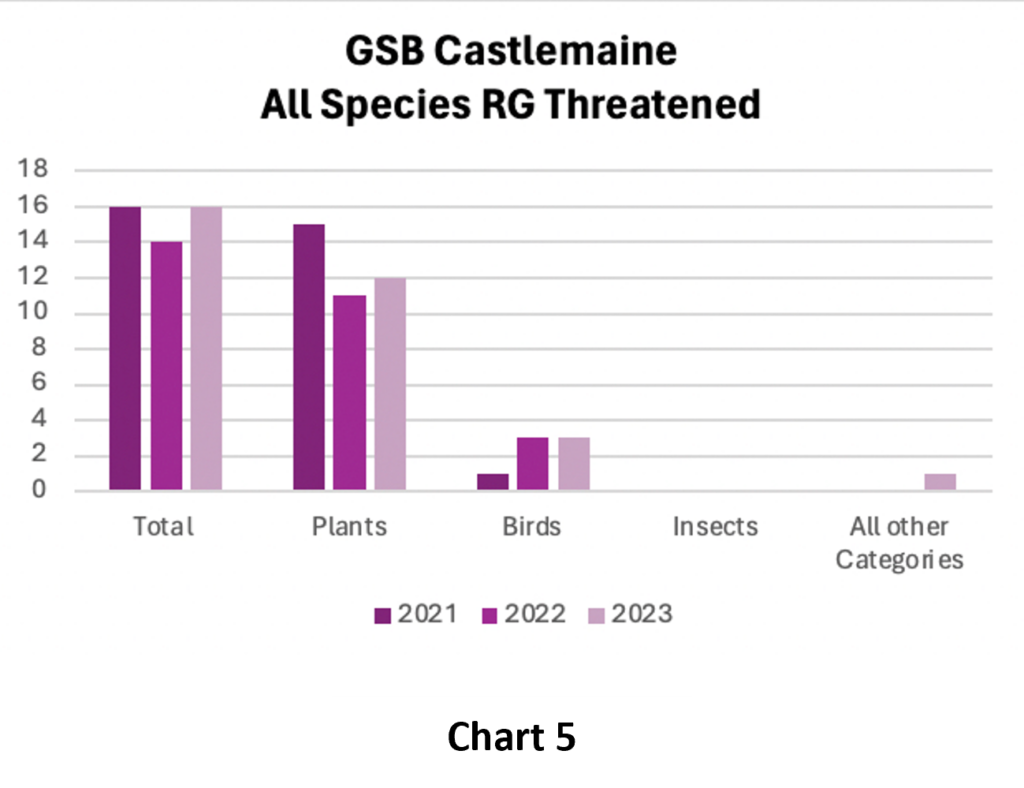
Threatened Species Native to our Region found during the GSBs
| Common Name | Scientific Name | Threat Category | 2021 | 2022 | 2023 |
|---|---|---|---|---|---|
| Hardhead Duck | Aythya australis | Vulnerable (FFG) | X | ||
| Musk Duck | Biziura lobata | Vulnerable (FFG) | X | X | |
| Gang-gang Cockatoo | Callocephalon fimbriatum | Endangered (EPBC) | X | X | |
| Powerful Owl | Ninox strenua | Vulnerable (FFG) | X | ||
| Diamond Firetail | Stagonopleura guttata | Vulnerable (FFG) | X | ||
| Koala | Phascolarctos cinereus | Endangered (EPBC) | X | ||
| Late-Flowered Flax-lily | Dianella tarda | Critically Endangered (FFG) | X | X | |
| Ornate Pink Fingers | Caladenia ornata | Endangered (FFG) | X | X | |
| Golden Cowslips | Diuris behrii | Endangered (FFG) | X | X | |
| Cassinia diminuta | Cassinia diminuta | Endangered (FFG) | X | ||
| River Red Gum | Eucalyptus camaldulensis | Near Threatend (IUCN) | X | X | |
| Wiry bossiaea | Bossiaea cordigera | Endangered (FFG) | X | ||
| Long-leaved Box | Eucalyptus goniocalyx | Vulnerable (IUCN) | X | X | |
| Yellow Gum | Eucalyptus leucoxylon | Vulnerable (IUCN) | X | X | |
| Yellow Box | Eucalyptus melliodora | Vulnerable (IUCN) | X | X | |
| Grey Box | Eucalyptus microcarpa | Endangered (IUCN) | X | X | |
| Red Box (Silver Dollar Gum) | Eucalyptus polyanthemos | Some sub-species | X | X | |
| Manna Gum | Eucalyptus viminalis | Near Threatend (IUCN) | X | ||
| Goldfields Grevillea | Grevillea dryophylla | Endangered (FFG) | X | X | |
| Small-flower Grevillea | Grevillea micrantha | Critically Endangered (FFG) | X | X | |
| Fryerstown Grevillea | Grevillea obtecta | Endangered (FFG) | X | X | X |
| Creeping Grevillea | Grevillea repens | Endangered (FFG) | X | ||
| Hairy Geebung | Persoonia rigida | Vulnerable (IUCN) | X | ||
| Dense Mint Bush | Prostanthera decussata | Endangered (FFG) | X | X | |
| Scented Bush-pea | Pultenaea graveolens | Endangered (FFG) | X | X | X |
